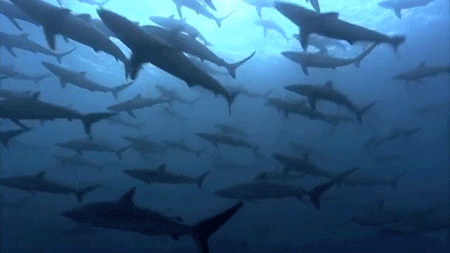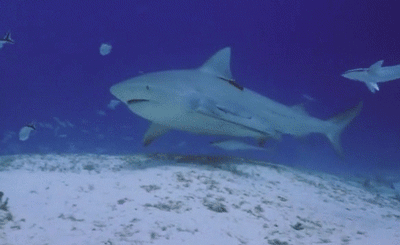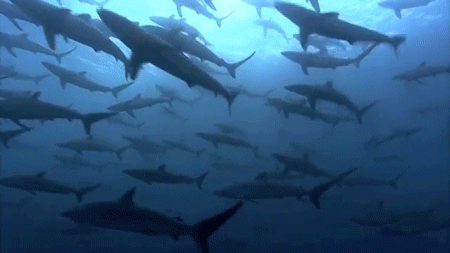Why Music Might Be Killing Sharks



Why music might be killing sharks
For too long, sharks have been portrayed and perceived as the menacing, lurking creatures in the deep. Contrary to popular belief, we are much more of a threat to them than they are to us.
Researchers have found that the ominous music that often accompanies even documentary footage of them has inspired excessive fear about sharks.
In an experiment at UC San Diego, participants watched footage of sharks. Some scenes featured uplifting music, and others had a more daunting score.
The effect was what you might expect. Viewers saw sharks as intimidating creatures when they they also heard ominous music.
But with uplifting music (or none at all), viewers had a more positive impression of sharks.
This is problematic because rarely do we see shark footage without the ominous music, and the negative portrayals of sharks may be hindering conservation efforts.
“We know from prior research that conservation progress for sharks is sluggish compared to marine mammals and that this slow response may be due in part to the societal marginalization of sharks,” says study co-author Elizabeth Keenan.
After all, in the words of Senegalese conservationist Baba Diou, “we will conserve only what we love.”
And while they’re still not exactly a furry, cuddly rabbit, consider this: you’re more likely to be struck by lightening than fall prey to a fatal shark attack.

More Posts from Curiositytherover and Others

The US space agency has just announced that it’ll be sticking four volunteers inside a tiny house for 30 days, as part of an experiment to test how isolation and “close quarters” affect people’s behaviour. Once inside, the volunteers can’t leave the cabin, and will only be able to regularly communicate with each other and NASA mission control (that means no Internet).
It sounds pretty uncomfortable, but if we want to make it further into space - all the way to Mars, for example - people are going to have to live in cramped spaces for months at a time with very little contact with the outside world, and scientists need to be able to predict the effects - including every little thing that could go wrong.
The compact, three-storey house that the volunteers will be living in is called the Human Research Exploration Analog (HERA), and it’s what NASA is calling a “science-making house”. That means there are lots of little experiments on board to keep the team occupied, like plants to grow and tiny shrimp to take care of.

E-paper sneakers change your style on the fly

DJI’s drone safety system has you signing up to fly in some areas
NASA gives MIT a humanoid robot to develop software for future space missions

We pulled together the week’s top tech stories, just for you:
1. Formula E is planning the first racing series for driverless cars You read that right: Before every Formula E race, two autonomous vehicles will go head-to-headlights, in a race straight out of every Sci-Fi fan’s wildest dreams. via: @engadget
2. How Technology Will Transform Retirement Someday in the near future, being selfish and obsessed with technology might be qualities that senior citizens praise today’s Millennials for. All around the world, young people are hard at work creating technology that will take care of them when they’re older. via: The Wall Street Journal
3. Who’s going to fly those Amazon delivery drones? The short answer is, probably no one. Which is for the best, really. After all, the real reason we don’t have flying cars is because people are bad drivers. And adding a z axis would be like trying to navigate rush-hour traffic in midair. via: ZDNet
4. Wayfindr Is on a Quest to Optimize Cities for the Visually Impaired After a successful experiment at London’s Pimlico Station and a recently received grant of $1 million from Google.org, this company wants to change the way visually impaired commuters navigate the London Underground. via: @wired

Rowing robot powers itself by gulping dirty water




The world is racing to build a moon base — here’s what it could look like
The European Space Agency just reminded the world that it wants to build a base on the moon by 2030, using 3-D printed parts made from materials found on the lunar surface. But the ESA has some stiff competition.
Solar System: 2015 Year in Review

Two mysterious worlds explored for the first time. Liquid water seen flowing on Mars. A global ocean discovered hiding inside a moon of Saturn. Even during our Era of audacious solar system exploration, 2015 stands out. Here are a few highlights:
1. New Horizons Reveals the Face of Pluto

Whether or not you call it a planet, Pluto entranced the people of Earth when it sent a love note from three billion miles away via our New Horizons spacecraft.
2. Dawn Comes to Ceres

The dwarf planet Ceres, the largest object in the main asteroid belt, teased explorers with its bizarre bright spots before finally giving up some of its secrets to the Dawn spacecraft. HERE are the latest findings.
3. Cassini Marks Discoveries and Milestones at Enceladus

When the Cassini spacecraft performs its final close flyby of Saturn’s icy moon Enceladus on Dec. 19, it will be a true milestone. Scientists using data from Cassini’s instruments have uncovered astounding secrets about this small moon, including (confirmed this year) the fact that its underground ocean of liquid water is global, and is home to hydrothermal vents.
4. We Confirmed Evidence that Liquid Water Flows on Today’s Mars

Findings from our Mars Reconnaissance Orbiter (MRO) provided the strongest evidence yet that liquid water flows intermittently — on present-day Mars.
5. Rosetta Passes Perihelion

The European Space Agency’s Rosetta mission had a remarkable year, re-establishing contact with the Philae lander and following comet 67P/Churyumov-Gerasimenko as it swung near the sun.
6. Mars Explorers Confirm Lakes Once Dotted Mars

A study from the team behind our Mars Science Laboratory/Curiosity Rover confirmed that Mars was once, billions of years ago, capable of storing water in lakes over an extended period of time.
7. MAVEN Finds a Culprit in the Loss of Mars’ Atmosphere

The Mars Atmosphere and Volatile Evolution (MAVEN) mission identified the process that appears to have played a key role in the transition of the Martian climate from an early, warm and wet environment that might have supported surface life to the cold, arid planet that Mars is today.
8. Akatsuki Gets a Second Chance at Venus

Five years after a mishap sent the spacecraft off course, the Japan Aerospace Exploration Agency (JAXA) successfully inserted the Venus Climate Orbiter “Akatsuki” into orbit around Venus. While the mission is not funded by NASA, an agency partnership with JAXA provides an opportunity for eight of our scientists to work with the Akatsuki team and study data from the spacecraft over the next year or so.
9. A Trailblazing Mission Sends Its Final Message from Mercury

After a flight of nearly 11 years, the highly successful MESSENGER mission ended when, as planned, the spacecraft slammed into the surface of Mercury.
10. Mars Reconnaissance Orbiter Completes 40,000 Orbits

Mars Reconnaissance Orbiter, at Mars since 2006, has orbited the Red Planet more than 40,000 times. The mission, which studies the whole planet from space, has shown that Mars is diverse and dynamic by way of many thousands of spectacular images and other kinds of data.
Make sure to follow us on Tumblr for your regular dose of space: http://nasa.tumblr.com
Chasing Storms at 17,500mph
Flying 250 miles above the Earth aboard the International Space Station has given me the unique vantage point from which to view our planet. Spending a year in space has given me the unique opportunity to see a wide range of spectacular storm systems in space and on Earth.
The recent blizzard was remarkably visible from space. I took several photos of the first big storm system on Earth of year 2016 as it moved across the East Coast, Chicago and Washington D.C. Since my time here on the space station began in March 2015, I’ve been able to capture an array of storms on Earth and in space, ranging from hurricanes and dust storms to solar storms and most recently a rare thunder snowstorm.

Blizzard 2016

Hurricane Patricia 2015

Hurricane Joaquin 2015

Dust Storm in the Red Sea 2015

Dust Storm of Gobi Desert 2015

Aurora Solar Storm 2015

Aurora Solar Storm 2016

Thunderstorm over Italy 2015

Lightning and Aurora 2016

Rare Thunder Snowstorm 2016
Follow my Year In Space on Twitter, Facebook and Instagram.






This is Tech Tats, tattoos that can track your health data and your personal information - watch the full video
-
 bitsofsciencelife reblogged this · 1 month ago
bitsofsciencelife reblogged this · 1 month ago -
 wildfeather5002 liked this · 1 year ago
wildfeather5002 liked this · 1 year ago -
 foxllore liked this · 1 year ago
foxllore liked this · 1 year ago -
 tumblruna reblogged this · 3 years ago
tumblruna reblogged this · 3 years ago -
 rms-erebus liked this · 4 years ago
rms-erebus liked this · 4 years ago -
 disgraced-space-ace liked this · 4 years ago
disgraced-space-ace liked this · 4 years ago -
 stop-and-think liked this · 4 years ago
stop-and-think liked this · 4 years ago -
 ubiquitous26 liked this · 4 years ago
ubiquitous26 liked this · 4 years ago -
 glitter-on-the-coast liked this · 4 years ago
glitter-on-the-coast liked this · 4 years ago -
 casneedsmyrrh reblogged this · 4 years ago
casneedsmyrrh reblogged this · 4 years ago -
 smoke-and-velvet liked this · 5 years ago
smoke-and-velvet liked this · 5 years ago -
 kakuncio reblogged this · 5 years ago
kakuncio reblogged this · 5 years ago -
 msmoonbeamdreams liked this · 5 years ago
msmoonbeamdreams liked this · 5 years ago -
 bredd-owo liked this · 5 years ago
bredd-owo liked this · 5 years ago -
 jzg-tofu reblogged this · 5 years ago
jzg-tofu reblogged this · 5 years ago -
 jzg-tofu liked this · 5 years ago
jzg-tofu liked this · 5 years ago -
 pikiserra liked this · 6 years ago
pikiserra liked this · 6 years ago -
 katsbag-stuff reblogged this · 6 years ago
katsbag-stuff reblogged this · 6 years ago -
 justsaylara reblogged this · 6 years ago
justsaylara reblogged this · 6 years ago -
 justsaylara liked this · 6 years ago
justsaylara liked this · 6 years ago -
 thatweirdartistthing liked this · 6 years ago
thatweirdartistthing liked this · 6 years ago -
 kingofbattletoasters liked this · 6 years ago
kingofbattletoasters liked this · 6 years ago -
 ace-chaos17 reblogged this · 6 years ago
ace-chaos17 reblogged this · 6 years ago -
 ace-chaos17 liked this · 6 years ago
ace-chaos17 liked this · 6 years ago -
 featheredcritter reblogged this · 6 years ago
featheredcritter reblogged this · 6 years ago -
 featheredcritter liked this · 6 years ago
featheredcritter liked this · 6 years ago -
 willowfoxthefox reblogged this · 6 years ago
willowfoxthefox reblogged this · 6 years ago -
 willowfoxthefox liked this · 6 years ago
willowfoxthefox liked this · 6 years ago -
 guloborealis reblogged this · 6 years ago
guloborealis reblogged this · 6 years ago -
 arte-art reblogged this · 6 years ago
arte-art reblogged this · 6 years ago -
 parasite-core liked this · 6 years ago
parasite-core liked this · 6 years ago -
 nepja liked this · 6 years ago
nepja liked this · 6 years ago -
 goron-king-darunia reblogged this · 6 years ago
goron-king-darunia reblogged this · 6 years ago -
 that-girl-you-probably-met-once liked this · 6 years ago
that-girl-you-probably-met-once liked this · 6 years ago -
 korbensdeliveryservice reblogged this · 6 years ago
korbensdeliveryservice reblogged this · 6 years ago